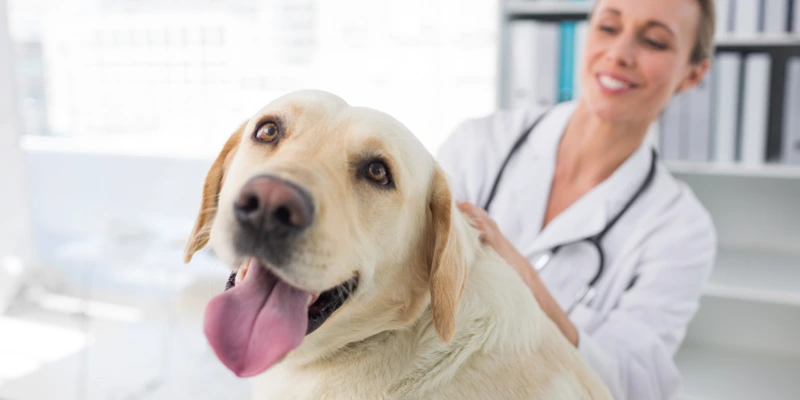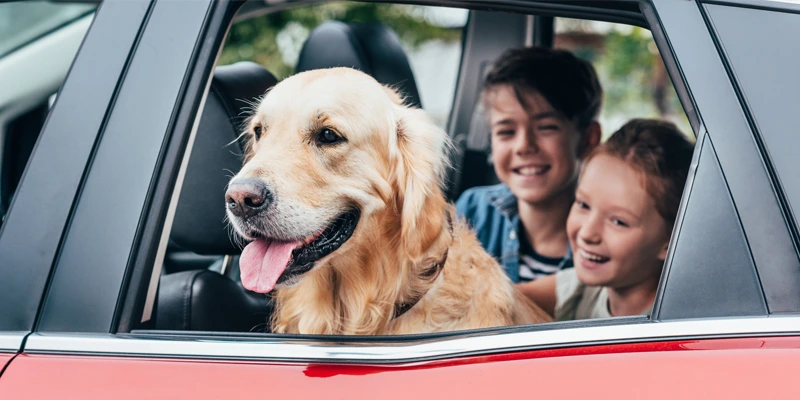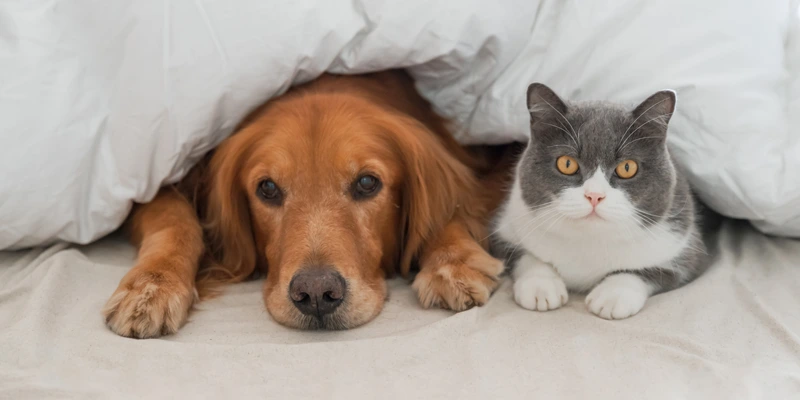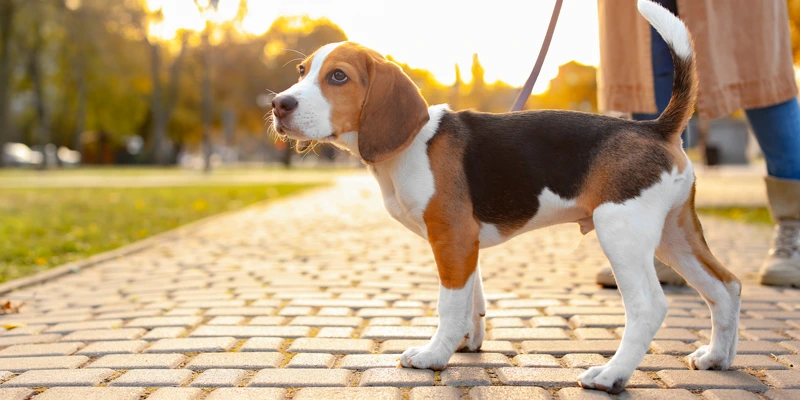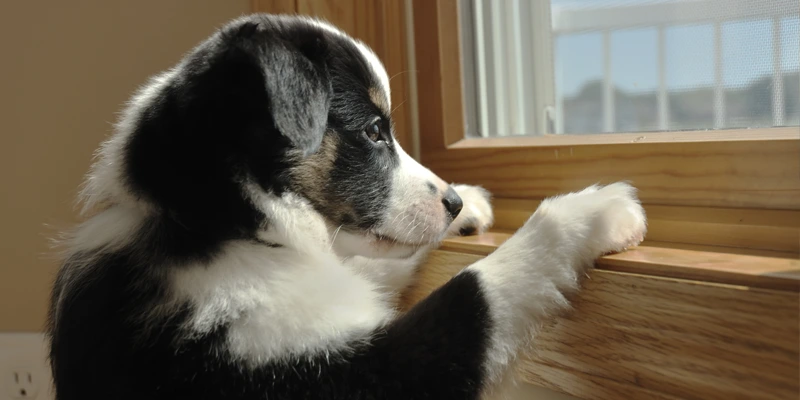Moving House with Pets: The Definitive Guide to a Stress-Free Move
Ready to make your move with your furry friends? This comprehensive guide will help you navigate the process smoothly and ensure a pawsitive experience for both you and your four-legged pals.
16 min read
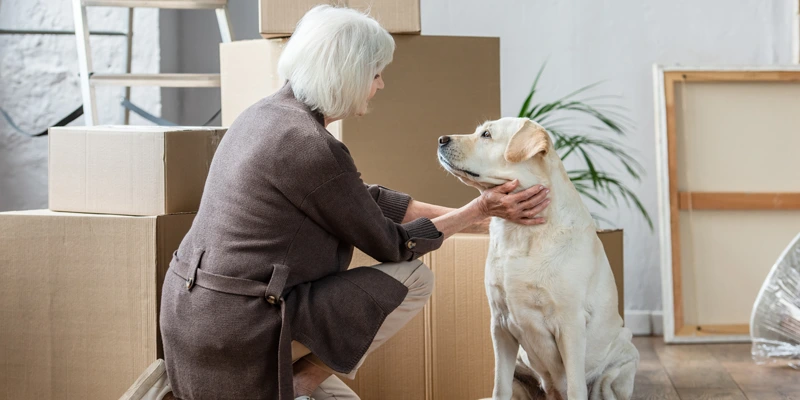
Key takeaways
- Plan ahead: Preparations for moving with pets should start well ahead of the moving date. This can include gradual acclimatisation to travel carriers, scheduling vet visits, and arranging pet-friendly accommodation.
- Maintain routine: Try to keep your pet's daily routine as consistent as possible during the move to help mitigate stress.
- Pack a pet essentials bag: This should include food, water, toys, a leash, and any medications your pet might need.
- Consider a pet sitter: On moving day, consider using a pet sitter or daycare to keep your pet safe and stress-free.
- Update pet information: Remember to update your pet's microchip information and tags with your new address.
- Settle in slowly: Allow your pet time to adjust to the new surroundings. Start by setting up a familiar space for your pet in the new home.
Moving house can be an incredibly stressful experience, and it can be even more overwhelming for our beloved pets. Just like us, animals thrive on routine and familiarity. So when their familiar surroundings suddenly change, it can cause them a great deal of anxiety and distress. These sudden changes can sometimes lead to behavioural or health issues, or make them withdraw. Managing the logistics of moving with pets - ensuring their safety and comfort during the journey, finding pet-friendly accommodations, and helping them settle into their new home - can add a whole new layer of complexity to the process. But fear not! The key to a successful move with pets lies in early preparation and understanding their unique needs and behaviours. So, let's embark on this journey together and make it as smooth as possible for our furry companions.
Preparing your pet for the move
Vet visits
- Schedule a check-up: Before you make your move, it's super important to schedule a check-up with your vet. This way, you can make sure your furry friend is in tip-top shape and ready for the journey.
- Update vaccinations: If it's time for your pet's vaccinations, make sure to get them updated before you move. This is especially important if you're heading to a place with different diseases or if your new home has specific vaccination requirements.
- Discuss anxiety remedies: Moving can be quite stressful for your pets. It's a great idea to talk to your vet about possible remedies for anxiety. They can suggest helpful methods or medications to keep your pet calm during the journey.
- Obtain health certifications: If you're moving across states or internationally, you'll need to get health certifications for your pet. These will include a current health certificate and proof of vaccinations. Don't forget to ask your vet about any specific health requirements for your new destination.
Pet identification
- Update ID tags: It's super important to make sure you update your pet's ID tags with your current phone number. That way, if your pet gets lost during the move, an updated tag can increase the chances of a safe return. It's also a good idea to include any other contact info that could be helpful.
- Microchipping: Getting your pet microchipped adds an extra layer of security. It's basically a tiny device implanted beneath their skin that stores your contact info. This comes in handy if your pet goes missing and their tags go AWOL. If your pet already has a microchip, make sure to update the details with your new address and contact info. If you're moving abroad, keep in mind that different countries have different microchipping standards, so it's always good to check the requirements at your new place.
- Consider GPS trackers: For some extra peace of mind, you might want to think about getting a GPS tracker for your pet. This cool technology lets you keep an eye on your pet's location in real time, which can be really handy during the chaos of a move. Plus, there are different models that can even alert you if your pet goes outside a set 'safe zone'.
Comfort items
- Pack your pet's favourite toys, blankets, or beds: Just like how we find comfort in the things we love, our furry friends do too! So, make sure to pack their most cherished toys, blankets, or beds. Having these familiar items with them during the move will give them a sense of security and help reduce their stress levels. After all, nothing beats the scent of home!
- The importance of familiar scents: Familiar smells can work wonders in keeping our pets calm and content. When your pet is in an unfamiliar environment, their favourite blanket or toy can be a source of comfort because it smells like home. This becomes especially important when you're settling into a new place, where everything else smells different. So, ensure that your pet has access to these special items to help them adjust more quickly to their new surroundings. They'll thank you with lots of tail wags and purrs!
Pet passports & regulations (for International Moves):
- Necessary documentation: So, when you're moving internationally with your furry friends, you'll need to get a pet passport for them. This document keeps track of all the treatments your pet has had. It's a way to show that your pet is good to go and doesn't carry any diseases. Just visit your vet to get it sorted, and make sure it includes stuff like microchipping date, rabies vaccination, and any blood tests. Oh, and remember, the requirements for a pet passport can vary depending on where you're heading. So, it's important to check out the specific rules of the country you're moving to.
- Quarantine requirements: Now, listen up! Some countries have this thing called compulsory quarantine for pets when they arrive. It's basically to make sure they're not bringing any diseases that could harm the local wildlife or other pets. Take Australia and New Zealand, for example; they've got strict quarantine rules that can last for weeks. So, do your homework and find out about these requirements well in advance. You'll want to be prepared, and of course, make sure you know about any pet facilities available and how you can make your pet's quarantine period as comfy as possible.
On moving day
Securing your pet
- Create a dedicated safe room: When it's moving day, set up a special room just for your furry friend. This way, they can stay safe and stress-free. Make sure the room is quiet, secure, and filled with their favourite things so they feel at home. Don't forget to provide food, water, and a litter box if needed. And, of course, let everyone involved in the move know that this room is off-limits to avoid any accidental escapes or disturbances.
- Choose the right carrier: It's important to have a carrier that's suitable for your pet's transportation. Look for one that's well-ventilated, secure, and spacious enough for them to move around comfortably. Line it with absorbent 'puppy pads' in case of any accidents, and add soft bedding to keep them cozy. You can even toss in their favourite toy or blanket for extra comfort.
- Get a pet sitter: Getting someone to look after your pet on moving day can be a great idea. It can help reduce your pet's stress levels as they can remain in a familiar environment with a trusted person, away from the chaos and confusion of the move. They can ensure your pet's routine is kept as normal as possible, provide feeding, walks or playtime, and also give them some much-needed attention and reassurance during this unsettling time.
- Keep escape in mind: Be super careful with doors and windows on moving day. Keep them closed at all times to prevent your pet from making a daring escape out of fear or stress. Before you start moving your pet, double-check that the carrier door is securely closed. If you're staying overnight somewhere, choose pet-friendly accommodation and keep your pet in their carrier until you're safely inside your room and have checked for any potential escape routes.
Travel considerations
If moving with larger animals such as dogs, it's crucial to take regular breaks during your journey. This allows them to stretch their legs, use the bathroom, and simply get a breather from the confines of their carrier. Make sure to use a secure leash or harness during these breaks to ensure your pet stays safe and nearby.
During these breaks, don't forget to provide your pet with food and water as needed. However, avoid feeding right before the trip to prevent motion sickness. Ideally, try feeding them a light meal 3-4 hours before the trip.
Monitoring for signs of anxiety or stress
Our furry friends can't communicate with words, so it's up to us to become skilled at understanding their body language. Keep a close eye on your pet for any signs of unease or tension. Look out for things like heavy panting, drooling, restlessness, whimpering, or seeking seclusion.
If you spot any of these signs, it's time to step in and help your furry friend feel better. You can try using calming aids, making some adjustments to their surroundings, or even reach out to a vet if their anxiety seems really intense. Just remember, your pet's wellbeing should always come first when you're going through a move.
Overnight kit
When you finally make it to your new home, it might take a bit of time to unpack and get everything in order. But hey, that's all part of the adventure, right? During this transition period, it's super important to have an overnight kit ready for your furry friend with all the must-haves. Trust me, you'll want to include:
- Enough food to keep their tummy satisfied for a couple of days.
- If you have a cat, a Litter for your cute little kitty.
- Grooming tools like brushes if your pet needs or enjoys a daily brush.
- A few of their absolute favourite toys. Having these goodies on hand will make your pet feel extra cozy and well taken care of during those first few days of settling in.
Settling into the new home
Safe spaces
So, the first thing you wanna do is make your pet feel right at home, you know? Set up their favourite bed, toys, and even use the same brand of food and water bowls. Having these familiar things around will help calm their nerves and make them feel more comfortable. Oh, and try to arrange everything just like it was in your old home, if you can.
Once your furry friend is settled in their safe spot, it's time to let them explore the rest of the house, step by step. Take it slow, though, to avoid overwhelming them. Start by letting them check out one new room at a time, with you keeping an eye on them, of course. And hey, be patient and give them plenty of time to adjust to each new space. They'll get there!
Getting your pet comfortable
Investing quality time with your pet is an important aspect of helping them acclimatise to their new environment. Engage in activities that your pet enjoys, such as playtime with their favourite toys, cuddles on the couch, or taking walks around the new neighbourhood. This not only helps to strengthen your bond but also encourages your pet to associate positive experiences with their new home.
New dangers
Hey, just a quick reminder that when you move to a new home, there are some new things to watch out for that could affect your pet's safety. The different environment might expose them to unfamiliar dangers like heavy traffic, wildlife, or pollutants. During those first few days, it's important to keep a close eye on your pet. Also, take some time to secure your property by checking for toxic plants in your garden and making sure your fences and gates are strong and secure. If you're in a busy area with pollution or heavy traffic, it might be a good idea to keep your pet indoors during peak hours to minimise their exposure. And don't forget to learn about the local wildlife and any potential threats they could pose to your furry friend. Above all, safety always comes first when settling into a new place!
Routine consistency
It's super important to stick to your pet's established routines as closely as possible during and after the move. Just think about it - regular feeding times, walk schedules, and playtimes provide so much comfort and serve as a reliable constant in their life amidst all the chaos of relocation. So, if your dog is used to a morning walk, make sure to keep that routine going in your new surroundings, even when things get a bit crazy with settling in. And hey, don't forget to keep those feeding times consistent too! Oh, and of course, take some time to play with your furry friend using their favourite toys. Trust me, these familiar routines will help your pet feel secure and adapt to the new environment in no time.
Exploring the new neighborhood
Pet-friendly places:
When you move to your new neighbourhood, it's important to find pet-friendly places for your furry buddy's socialisation and well-being. Look out for local parks that are dog-friendly and perfect for walks and playtime with other pups. And guess what? There are also pet-friendly cafes and eateries where your four-legged friend is welcome! They even provide water bowls and dog treats, so you can enjoy a meal or a cup of tea without leaving your pet at home. Don't forget to locate nearby pet shops for supplies and a local vet for check-ups and emergencies. The more familiar the surroundings, the quicker your pet will settle in. It's like a whole new world out there, waiting to welcome you and your furry friend!
Local etiquette
Understanding the local etiquette is super important to make sure things go smoothly for you and your furry friend. Different places have different rules for pets and their owners, so it's good to know what's acceptable. For example, some spots might have leash laws, meaning your dog needs to be on a leash in public. But there might also be cool off-leash areas where your pup can run wild. Just make sure you're aware of these rules to avoid any misunderstandings or fines.
Remember to always have poop bags with you when you're outside. Be responsible and ensure you pick up after your dog. Being a responsible pet owner isn't just about looking after your pet, it's also about being respectful to your community. Following these etiquettes will help your pet make a good impression in the new neighbourhood and build positive relationships with your neighbours.
Planning for the unexpected
Contingency planning
The last thing any pet owner wants to think about is their furry friend escaping or getting lost in a new place. But being prepared for this kind of situation is really important when moving to a new area. If your pet does manage to slip away (fingers crossed it never happens!), don't panic. Start by searching around your immediate area, ask your lovely neighbours if they've seen your pet, and put up some flyers in your local community with your pet's photo and your contact details.
Anxiety or behavior issues
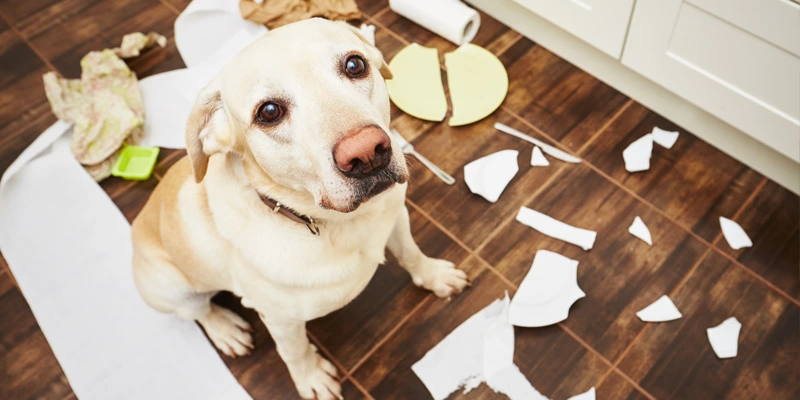
It's important to recognise the signs that they're feeling stressed. Changes in their behaviour, like becoming more aggressive, withdrawn, or vocal, could be signs of stress. You might also notice physical changes such as excessive shedding, changes in appetite, or disrupted sleep. Sometimes, they might even show repetitive or compulsive behaviours like pacing or excessive grooming as a response to stress. If you spot any of these signs, it's a good idea to chat with a vet or a pet behaviourist who can provide guidance on how to help your pet cope with the changes and reduce stress levels. Remember, during this transition period, it's crucial to approach your furry friend with patience and understanding.
Some of the different types of products available to help ease your pet's anxiety include:
- Calming collars: Infused with pheromones, these collars reduce pet anxiety by releasing a comforting scent.
- Calming sprays: Similar to collars, sprays contain soothing pheromones that can be used in your pet's new environment.
- Anxiety wraps or thundershirts: These garments apply gentle, constant pressure to reduce anxiety and fear.
- Interactive toys: Mentally challenging toys can keep pets occupied and help them adjust.
- Calming treats or supplements: Treats with natural calming ingredients can be a good option.
Remember, consult your vet before introducing new products or remedies.
Pet emergency contacts
Compile a list of emergency contact numbers: nearby 24/7 vet clinics, animal hospitals, and pet services.
Understanding the emotional impact
Grieving the old home
Pets, just like us humans, can feel a sense of loss when they're taken away from their familiar surroundings. They might miss their old territory, neighbours, or even the smells and sights they were used to. This grieving process can show up in different ways, like changes in their behaviour, eating habits, or energy levels. It's important to recognise that this is a natural response to change and offer the right emotional support to your furry friend during this time.
The key to helping your pet through this grieving period is to be patient and comforting. Stick to their regular routines to give them a sense of stability. Spend quality time with them, doing their favourite activities and giving extra snuggles and reassurance. Ease them into their new surroundings gradually, starting with short exploration sessions around the new home before venturing out into the neighbourhood.
Make their new space more comforting by providing them with familiar objects like their beloved toys or bedding. This will help them feel more at home. If the grieving seems to go on for a while or if your pet appears to be really distressed, it's a good idea to seek professional advice from a vet or pet behaviourist. They can help you understand if your pet needs additional support, such as behavioural therapy or medication, during this time.
Remember, moving to a new home is a big change for your pet, and it's completely normal for them to take some time to adjust. Being there for them, understanding their feelings, and creating a supportive environment will go a long way in helping them settle into their new abode.
Watching for new fears
Our pets might get anxious about strange noises or unfamiliar animals nearby. You might notice them being extra alert or hiding. It's important to understand their stress responses and give them time to adjust.
One thing that can make them anxious is the new sounds in the house, like creaky floorboards or buzzing appliances. To help them get used to it, start by introducing the sounds slowly and gradually increase the volume over time. And don't forget to reward them with treats or praise to create positive associations.
If your pet seems nervous around new animals, take it slow. gradually Introduce them little by little, and reward them for staying calm. As time goes on, you can decrease the distance between them and the new animal while still rewarding good behaviour.
Tech to the rescue
Pet monitoring cameras.
With the rise of technology, it's now easier than ever to keep an eye on your pet when you're away from home. Pet monitoring cameras are a game-changer! They let you remotely check in on your pets, which is especially handy when they're getting used to a new environment. These cameras not only give you a live view, but some of the fancier models even have cool features like two-way audio, night vision, and treat dispensers. So you can watch, talk to, and even treat your pet from wherever you are, keeping them safe and happy in their new digs.
Pet relaxation apps
Taking care of your pet's emotional well-being is just as important as their physical comfort. That's where pet relaxation apps come in. These apps can make a real difference! They play soothing music or sounds specifically designed for different pets, helping to ease their stress and anxiety. The soundtracks often include calming elements like nature sounds, soft tunes, or even special frequencies that animals find relaxing. Whether it's a thunderstorm, separation anxiety, or just the need for some chill time, these apps are a great tool for looking after your pet's emotional health.
Extra tips for moving with dogs
- Safety first in the car
If you're travelling by car, it's a good idea to invest in a top-notch dog seat belt, travel crate, or barrier to keep your dog safe. Remember, never let your dog ride in the back of an open truck or hang out of a window. Safety first, woof woof! - Keep familiar items handy
Dogs love having their own familiar things. So, when you're setting up your new place, make sure to give your dog access to their beloved bed, toys, and feeding dishes right from the start. - Dog training refresh
Moving to a new place can bring out some unexpected behaviours in our dogs That's why it's a great idea to give them a quick refresher course in basic obedience training. It'll help reinforce good behaviour in their new home and make them feel more settled. - Start with short absences
After you've settled in, give your dog some alone time in the new house for short periods. Slowly increase the duration to help them adjust to their new environment and get comfortable being on their own. - Throw a doggy housewarming
Once you're all settled, why not invite a few friends or neighbours over (bonus if they have well-behaved pets) for a cosy get-together? It's a great way to help your furry friend get accustomed to new faces and scents.
Extra tips for moving with cats
Cats are famously territorial creatures and can find moving home especially disorientating. Here are some extra tips to make the transition easier for your feline friend:
- Familiarise through scent
Cats use scent to familiarise themselves. Before moving, rub a soft cloth on your cat and then rub it around your new home to spread its scent. This will make the environment feel more familiar. - Use pheromone sprays
There are sprays available that mimic feline facial pheromones, which have a calming effect on cats. Consider using these in your new home to help reduce your cat’s stress. - Secure windows and balconies
Cats are curious creatures. Ensure that windows, balconies, and other high places are secure to prevent any escape or injury. - Check hidden spots
Cats might seek out hidden nooks or spaces in a new environment. Check behind appliances, under beds, or in closets to ensure your cat hasn't found a too-cozy hiding spot. - Monitor litter box use
Changes in litter box habits can indicate stress or health issues. Keep an eye on how frequently your cat is using the box, and check for any changes in their waste. - Stay calm
Cats are adept at picking up on human emotions. If you're stressed or anxious, your cat may mirror those feelings. Taking deep breaths and maintaining calm can help both of you adjust. - Night lights
Use night lights to help your cat navigate the new environment during nighttime. This can prevent accidental injuries or spills.
Alright, let's wrap things up
So, here's the deal. When it comes to moving and helping your pets adjust, patience and understanding are key. Just like us, our furry pals need time to adapt to new surroundings. It's important to recognise that and show them empathy to ease their stress during this transition. Oh, and let's not forget about preparation! Anticipating their needs, understanding their behaviour, and being ready for the unexpected can really make things smoother.
Also, staying in the loop with your new community, connecting with local pet groups, and keeping an eye on any changes in your pet's behaviour is super important.
But hey, amidst all the planning and changes, remember to find joy in this journey! Moving to a new home is not just about overcoming challenges, it's about creating amazing new memories with your furry friends. Embrace these new experiences and enjoy watching your pets explore their new territory, make new friends, and gradually turn this unfamiliar place into their beloved home. Trust me, the love, bonds, and memories you'll create in this new space will totally be worth all the effort. Cheers!
Ready to Move? Find Your Perfect Mover!
Don't let moving stress you out. Compare quotes from our network of reliable movers, read genuine reviews, and book with ease. Save time, save money, and start your move with confidence today.
- Quickly compare movers
- Read verified reviews
- Book online with confidence

